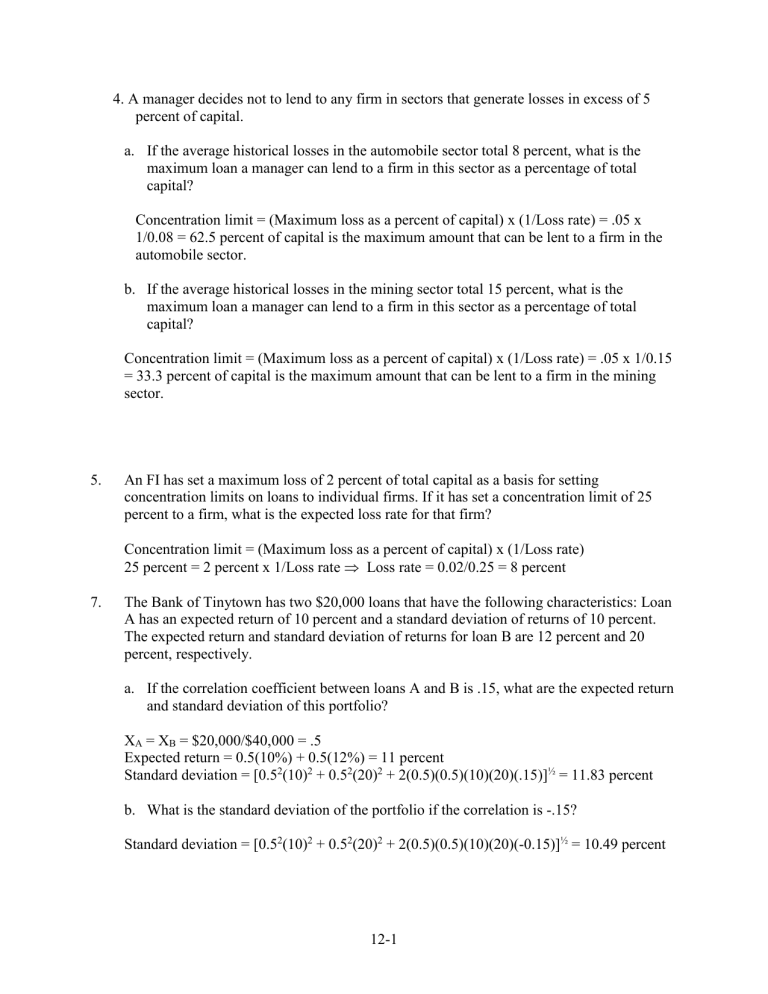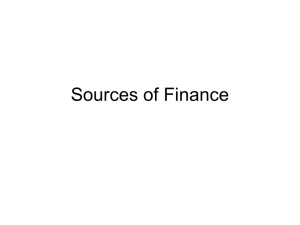Loan Portfolio Management: Problems & Solutions

4. A manager decides not to lend to any firm in sectors that generate losses in excess of 5 percent of capital. a. If the average historical losses in the automobile sector total 8 percent, what is the maximum loan a manager can lend to a firm in this sector as a percentage of total capital?
Concentration limit = (Maximum loss as a percent of capital) x (1/Loss rate) = .05 x
1/0.08 = 62.5 percent of capital is the maximum amount that can be lent to a firm in the automobile sector. b. If the average historical losses in the mining sector total 15 percent, what is the maximum loan a manager can lend to a firm in this sector as a percentage of total capital?
Concentration limit = (Maximum loss as a percent of capital) x (1/Loss rate) = .05 x 1/0.15
= 33.3 percent of capital is the maximum amount that can be lent to a firm in the mining sector.
5. An FI has set a maximum loss of 2 percent of total capital as a basis for setting concentration limits on loans to individual firms. If it has set a concentration limit of 25 percent to a firm, what is the expected loss rate for that firm?
Concentration limit = (Maximum loss as a percent of capital) x (1/Loss rate)
25 percent = 2 percent x 1/Loss rate
Loss rate = 0.02/0.25 = 8 percent
7. The Bank of Tinytown has two $20,000 loans that have the following characteristics: Loan
A has an expected return of 10 percent and a standard deviation of returns of 10 percent.
The expected return and standard deviation of returns for loan B are 12 percent and 20 percent, respectively. a. If the correlation coefficient between loans A and B is .15, what are the expected return and standard deviation of this portfolio?
X
A
= X
B
= $20,000/$40,000 = .5
Expected return = 0.5(10%) + 0.5(12%) = 11 percent
Standard deviation = [0.5
2
(10)
2
+ 0.5
2
(20)
2
+ 2(0.5)(0.5)(10)(20)(.15)]
½
= 11.83 percent b. What is the standard deviation of the portfolio if the correlation is -.15?
Standard deviation = [0.5
2 (10) 2 + 0.5
2 (20) 2 + 2(0.5)(0.5)(10)(20)(-0.15)]
½
= 10.49 percent
12-1
c. What role does the covariance, or correlation, play in the risk reduction attributes of modern portfolio theory?
The risk of the portfolio as measured by the standard deviation is reduced when the covariance is reduced. If the correlation is less than +1.0, the standard deviation of the portfolio will always be less than the weighted average of the standard deviations of the individual assets.
12. CountrySide Bank uses the KMV Portfolio Manager model to evaluate the risk-return characteristics of the loans in its portfolio. A specific $10 million loan earns 2 percent per year in fees, and the loan is priced at a 4 percent spread over the cost of funds for the bank.
Because of collateral considerations, the loss to the bank if the borrower defaults will be 20 percent of the loan’s face value. The expected probability of default is 3 percent. What is the anticipated return on this loan? What is the risk of the loan?
Expected return = AIS i
– E(L i
) = (0.02 + 0.04) – (0.03 x 0.20) = .054 or 5.4 percent
Risk of the loan =
Di
x LGD i
= [0.03(0.97)]
½
x 0.20 = 0.0341 or 3.41 percent
14. Information concerning the allocation of loan portfolios to different market sectors is given below:
Sectors
Commercial
Consumer
Real Estate
Allocation of Loan Portfolios in Different Sectors (%)
National
30%
Bank A
50%
Bank B
10%
Bank A and bank B would like to estimate how much their portfolios deviate from the national average.
40%
30%
30%
20%
40%
50% a. Which bank is further away from the national average?
Bank B
(
Using Xs to represent portfolio holdings:
Bank A
X
1j -
X
1 )
2
( X
2j -
X
2 )
2
( X
3j -
X
3 )
2
(50 - 30)2 = 400
(30 - 40)2 = 100
(20 -.30)2 = 100 i n
1
( X
ij
X i
)
2 n i
3
1
600
(10 - 30)2 = 400
(40 - 40)2 = 0
(50 - 30)2 = 400 n i
3
1
800
n
i
1
( X ij n
X i
)
2
= 14.14 percent
Bank B deviates from the national average more than Bank A.
= 16.33 percent
12-2
b. Is a large standard deviation necessarily bad for an FI using this model?
No, a higher standard deviation is not necessarily bad for an FI because the FI could have comparative advantages that are not required or available to a national well-diversified bank. For example, a bank could generate high returns by serving specialized markets or product niches that are not well diversified. Further, an FI could specialize in only one product, such as mortgages, but be well-diversified within this product line by investing in several different types of mortgages that are distributed both nationally and internationally.
This would still enable it to obtain portfolio diversification benefits that are similar to the national average.
16. Over the last ten years, the bank has experienced the following loan losses on its C&I loans, consumer loans, and total loan portfolio.
Year C&I Loans Consumer Loans Total Loans
2009
2008
2007
0.0080
0.0088
0.0100
0.0165
0.0183
0.0210
0.0075
0.0085
0.0100
2006
2005
2004
2003
2002
2001
2000
0.0120
0.0104
0.0084
0.0072
0.0080
0.0096
0.0144
0.0255
0.0219
0.0174
0.0147
0.0165
0.0201
0.0309
0.0125
0.0105
0.0080
0.0065
0.0075
0.0095
0.0155
Using regression analysis on historical loan losses, a bank has estimated the following:
XC = 0.002 + 0.8XL and Xh = 0.003 + 1.8XL where XC = loss rate in the commercial sector, Xh = loss rate in the consumer (household) sector, XL = loss rate for its total loan portfolio. a. If the bank’s total loan loss rates increase by 10 percent, what are the increases in the expected loss rates in the commercial and consumer sectors?
Commercial loan loss rates will increase by 0.002 + 0.8(0.10) = 8.20 percent.
Consumer loan loss rates will increase by 0.003 + 1.8(0.10) = 18.30 percent. b. In which sector should the bank limit its loans and why?
The bank should limit its loans to the consumer sector because the loss rates are systematically higher than the loss rates for the total loan portfolio. Loss rates are lower for
12-3
the commercial sector. For a 10 percent increase in the total loan portfolio, the consumer loss rate is expected to increase by 18.30 percent, as opposed to only 8.2 percent for the commercial sector.
12-4








